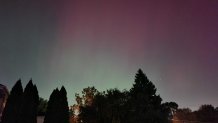The Northern Lights were visible across much of the Chicago area and Illinois Thursday evening amid a massive geomagnetic storm bringing auroras to latitudes much further south than normal.
The G4 geomagnetic storm is impacting the Earth right now, with the phenomenon caused by a significant coronal mass ejection that began affecting Earth's atmosphere Thursday morning, with the effects possibly continuing for at least two days.
The Northern Lights are generally visible only at higher latitudes, but instances like this week’s geomagnetic storm can cause those particles to be visible across greater distances.
Here's a look at some of the pictures captured around the Chicago area:






Feeling out of the loop? We'll catch you up on the Chicago news you need to know. Sign up for the weekly Chicago Catch-Up newsletter.











Fluctuations in the number of solar particles hitting Earth's atmosphere is difficult to predict, according to officials, but the effects of the CME could stick around for several days.
Local
Though the lights may be visible with the naked eye, pictures taken with digital cameras may make auroras more visible.
A consequence of the solar storm could be impacted communications, which could hinder rescue efforts in the aftermath of Hurricane Milton. According to officials, systems that “depend on low-Earth orbit satellites or high-frequence communication” could be interrupted, along with GPS navigation systems.
There are tools to help mitigate those issues, and FEMA has infrastructure in place to help prevent the worst impacts, according to the SWPC.
The Northern Lights are enhanced when coronal mass ejections, or CME’s, erupt from the sun and speed across space before hitting Earth’s atmosphere. According to the SWPC, CME’s are “large explosions of plasma and magnetized particles from the Sun’s corona.” Those ejections expand in size as they approach Earth’s atmosphere, and can cause geomagnetic storms when they arrive.
The Northern Lights occur when those charged particles hit Earth’s magnetic field, interacting with atoms and molecules in the upper atmosphere and producing brilliant and wavy colors in the sky.



